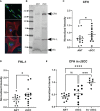Complement Factor H in cSCC: Evidence of a Link Between Sun Exposure and Immunosuppression in Skin Cancer Progression
- PMID: 35223500
- PMCID: PMC8869607
- DOI: 10.3389/fonc.2022.819580
Complement Factor H in cSCC: Evidence of a Link Between Sun Exposure and Immunosuppression in Skin Cancer Progression
Abstract
Cutaneous squamous cell carcinoma (cSCC) is a common form of skin cancer with an estimated 750,000 cases diagnosed annually in the United States. Most cases are successfully treated with a simple excision procedure, but ~5% of cases metastasize and have a 5-year survival rate of 25-45%. Thus, identification of biomarkers correlated to cSCC progression may be useful in the early identification of high-risk cSCC and in the development of new therapeutic strategies. This work investigates the role of complement factor H (CFH) in the development of cSCC. CFH is a regulatory component of the complement cascade which affects cell mediated immune responses and increases in complement proteins are associated with poor outcomes in multiple cancer types. We provide evidence that sun exposure may increase levels of CFH, suggesting an immunomodulatory role for CFH early in the development of cSCC. We then document increased levels of CFH in cSCC samples, compared to adjacent normal tissue (ANT) routinely excised in a dermatology clinic which, in paired samples, received the same level of sun exposure. We also provide evidence that levels of CFH are even greater in more advanced cases of cSCC. To provide a potential link between CFH and immune modulation, we assessed immune system function by measuring interferon gamma (IFN-γ) and FOXP3 in patient samples. IFN-γ levels were unchanged in cSCC relative to ANT which is consistent with an ineffective cell-mediated immune response. FOXP3 was used to assess prevalence of regulatory T cells within the tissues, indicating either a derailed or inhibitory immune response. Our data suggest that FOXP3 levels are higher in cSCC than in ANT. Our current working model is that increased CFH downstream of sun exposure is an early event in the development of cSCC as it interferes with proper immune surveillance and decreases the effectiveness of the immune response, and creates a more immunosuppressive environment, thus promoting cSCC progression.
Keywords: Complement Factor H; FOXP3; complement cascade; cutaneous squamous cell carcinoma (cSCC); immunoevasion; immunomodulation; interferon gamma (IFNγ); sun exposure.
Copyright © 2022 Johnson, Uppalapati, Pascual, Estrada, Averitte, Leyva and Hull.
Conflict of interest statement
The authors declare that the research was conducted in the absence of any commercial or financial relationships that could be construed as a potential conflict of interest.
Figures






Similar articles
-
Complement factor H: a biomarker for progression of cutaneous squamous cell carcinoma.J Invest Dermatol. 2014 Feb;134(2):498-506. doi: 10.1038/jid.2013.346. Epub 2013 Aug 12. J Invest Dermatol. 2014. PMID: 23938460
-
New perspectives on role of tumor microenvironment in progression of cutaneous squamous cell carcinoma.Cell Tissue Res. 2016 Sep;365(3):691-702. doi: 10.1007/s00441-016-2457-z. Epub 2016 Jul 14. Cell Tissue Res. 2016. PMID: 27411692 Review.
-
Response of advanced cutaneous squamous cell carcinoma to immunotherapy: case report.Stem Cell Investig. 2021 Sep 6;8:19. doi: 10.21037/sci-2020-071. eCollection 2021. Stem Cell Investig. 2021. PMID: 34631872 Free PMC article.
-
European interdisciplinary guideline on invasive squamous cell carcinoma of the skin: Part 1. epidemiology, diagnostics and prevention.Eur J Cancer. 2020 Mar;128:60-82. doi: 10.1016/j.ejca.2020.01.007. Epub 2020 Feb 26. Eur J Cancer. 2020. PMID: 32113941
-
The Role of p53 in Progression of Cutaneous Squamous Cell Carcinoma.Cancers (Basel). 2021 Sep 7;13(18):4507. doi: 10.3390/cancers13184507. Cancers (Basel). 2021. PMID: 34572732 Free PMC article. Review.
Cited by
-
Complement factor H: a novel innate immune checkpoint in cancer immunotherapy.Front Cell Dev Biol. 2024 Feb 8;12:1302490. doi: 10.3389/fcell.2024.1302490. eCollection 2024. Front Cell Dev Biol. 2024. PMID: 38389705 Free PMC article. Review.
-
Whole genome analysis reveals the genomic complexity in metastatic cutaneous squamous cell carcinoma.Front Oncol. 2022 Aug 2;12:919118. doi: 10.3389/fonc.2022.919118. eCollection 2022. Front Oncol. 2022. PMID: 35982973 Free PMC article.
-
The Interferon Gamma-Related Long Noncoding RNA Signature Predicts Prognosis and Indicates Immune Microenvironment Infiltration in Colon Adenocarcinoma.Front Oncol. 2022 Jun 7;12:876660. doi: 10.3389/fonc.2022.876660. eCollection 2022. Front Oncol. 2022. PMID: 35747790 Free PMC article.
-
Serum Complement Factor H: A Marker for Progression and Outcome Prediction Towards Immunotherapy in Cutaneous Squamous Cell Carcinoma.Cancers (Basel). 2025 Jun 26;17(13):2162. doi: 10.3390/cancers17132162. Cancers (Basel). 2025. PMID: 40647461 Free PMC article.
References
-
- Wells JW, Neters AD. Cutaneous Squamous Cell Carcinoma. In: Medscape. (2021). Available at: https://emedicine.medscape.com/article/1965430 (Accessed December 29, 2021).
LinkOut - more resources
Full Text Sources
Other Literature Sources
Miscellaneous

